LiDAR SLAM is a crucial component in robotics perception, widely used in both industry and academia for its efficiency and robustness in localization and mapping. In robotics perception research, LiDAR SLAM stands as a distinct field due to the variety of scenarios it must handle, such as indoor and outdoor environments, high speed of the ego-vehicle, dynamic objects, varying weather conditions, and the need for real-time processing etc. These complexities make LiDAR SLAM a critical area of study and innovation.
It’s fascinating how LiDAR SLAM can produce such structured and dense maps. At first glance, these maps might seem like the output of a deep learning model, but they are the result of sophisticated mathematical techniques and computer science principles. The field of LiDAR SLAM has evolved significantly, with research expanding each year from traditional mathematical approaches to incorporating deep learning methods, making it a rich and dynamic area of study.
This is the fifth article in our robotics series. So far, we’ve explored Monocular SLAM using OpenCV Python, provided a setup guide for ROS 2 with Carla, and dedicated an article to the workings and internals of ROS 2. In this post, we’ll understand LiDAR SLAM, focusing on two groundbreaking papers on LiDAR Odometry and Mapping:
- LOAM: Lidar Odometry and Mapping in Real-time
- LeGO-LOAM: Lightweight and Ground-Optimized Lidar Odometry and Mapping on Variable Terrain
We have provide a detailed mathematical understanding of both papers and a code explanation for LeGO-LOAM. Finally, we’ll show you how to run LeGO-LOAM in ROS 2. A thorough understanding of LiDAR SLAM is crucial, as we will utilize it in our final project of this blog post series: Building a 6DoF Autonomous Vehicle for Static Obstacle Avoidance Using ROS 2 and Carla.
NB: To set up ROS 2, refer to our ROS 2 Carla setup article, as we’ll be using it in this post.
- What is LiDAR SLAM?
- Types of Approach to LiDAR SLAM
- Paper Summary : LOAM – LiDAR Odometry and Mapping in Real-time
- LeGO-LOAM Paper Summary and Code Explanation
- Setup and Run LeGO-LOAM with ROS 2
- Key Takeaways
- Conclusion
- References
What is LiDAR SLAM?
The problem statement of LiDAR SLAM is formulated as follows,
Input: Given, a sequence of LiDAR scans of the environment from time ![]() , to
, to ![]() , represented as,
, represented as, ![]() .
.
Output: Find the trajectory of the LiDAR (robot) ![]() ,
, ![]() is the pose (
is the pose (![]() ) of the LiDAR and the map of the environment
) of the LiDAR and the map of the environment ![]() ,
, ![]() represents the 3D coordinates of the point cloud points corresponding to the environment. In the below image we represented the position of the LiDAR w.r.t the World coordinate as
represents the 3D coordinates of the point cloud points corresponding to the environment. In the below image we represented the position of the LiDAR w.r.t the World coordinate as ![]() .
.
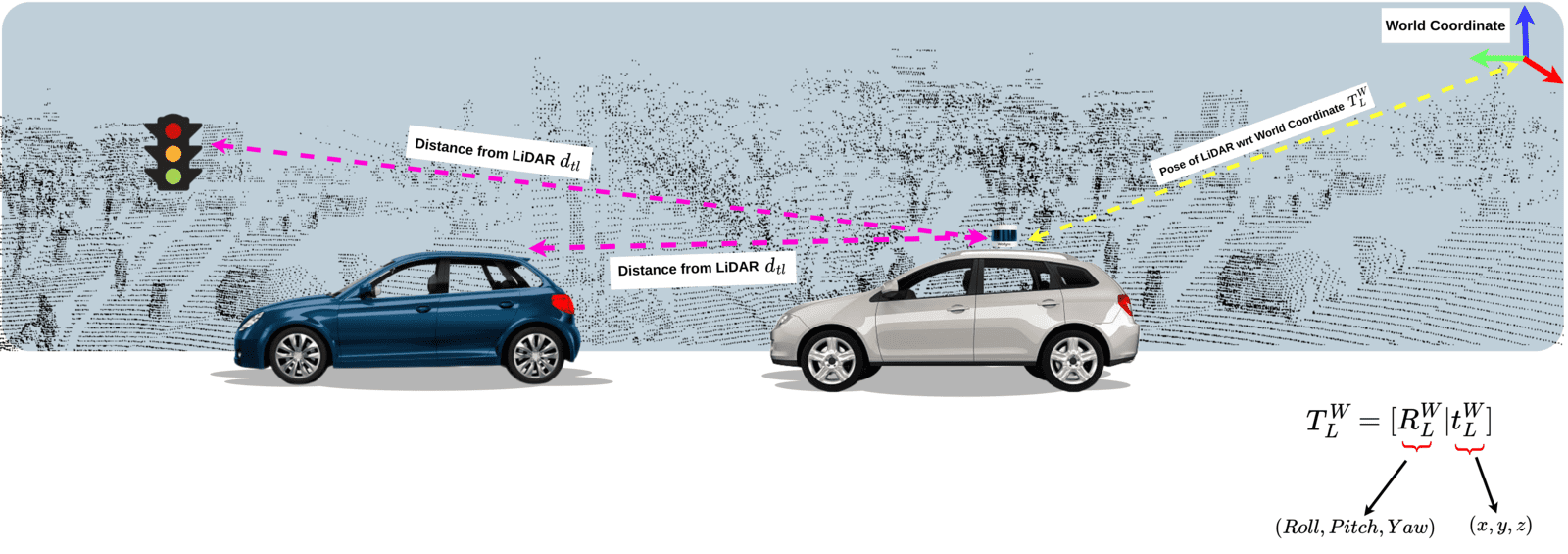
Algorithm:
LOAM is similar to Visual SLAM. There are always these common steps,
- Extract feature points (corner and planar points) from the LiDAR scan at time
 .
. - Establish correspondences for these feature points between the scan at time
 and the subsequent scan at time
and the subsequent scan at time  .
. - Estimate the LiDAR’s ego-motion (its movement and orientation) by minimizing the distance between corresponding feature points.
- Align the current scan with the previous scan using the estimated ego-motion to produce a coherent point cloud map.
- Apply backend optimization algorithms to refine the LiDAR’s pose and construct an accurate, consistent map of the environment.
Types of Approach to LiDAR SLAM
LiDAR SLAM stands out from visual SLAM with its high mapping accuracy, stability, and resistance to issues like illumination changes and scale drift, making it ideal for large-scale applications. The integration of multi-sensor fusion, such as LiDAR-Inertial, LiDAR-Visual, and LiDAR-Inertial-Visual systems, further enhances localization accuracy and robustness, addressing challenges like motion distortions, occlusions, and long-term mapping. This advancement in LiDAR SLAM technology is driving significant progress in intelligent perception applications such as autonomous driving, military navigation, and deep underground space/terrain exploration.
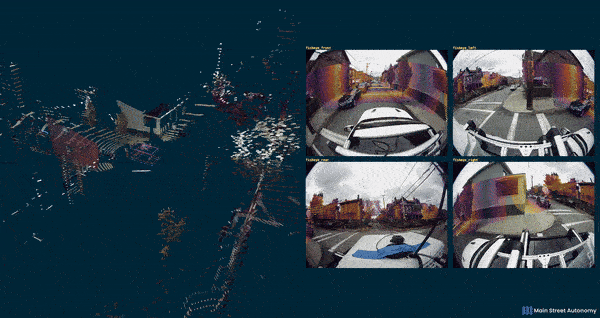
Based on the literature survey, we can understand that research has mostly focused on 4 types of LiDAR-only Odometry/SLAM methods.
- Feature Based: Extracts distinct geometric features such as edges and corners from lidar data to align and match points.
- Direct Methods: Directly minimizing the difference between Lidar scans to calculate the orientation and translation of Lidar. Direct methods are much easier to implement from an implementation point of view.
- Projection Based: Projects LiDAR data onto 2D planes or images for easier integration and processing with other sensor data.
- Deep Learning Based: Employs deep neural networks to automatically learn and extract features from LiDAR data for localization and mapping eg: LO-Net, L3-Net, LiDAR-MOS etc.
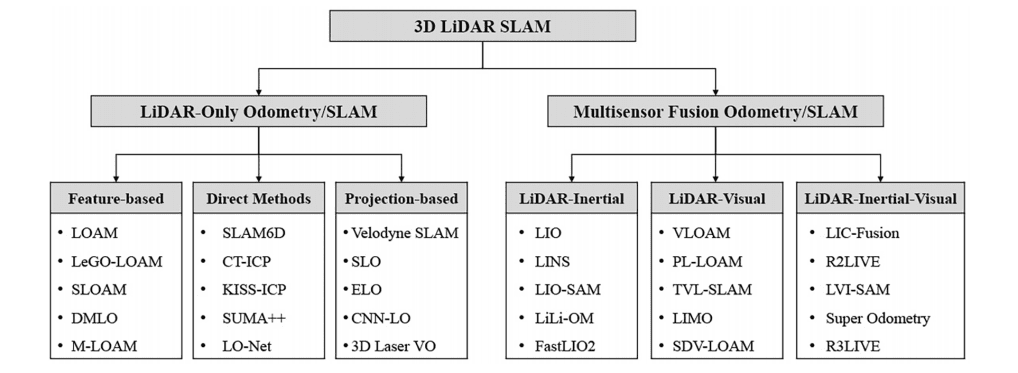
In this article, we will focus mainly on the featured-based LiDAR SLAM solution, specifically the LOAM literature, covering Zhang & Singh et al. paper on LiDAR SLAM and also LeGO-LOAM.
Paper Summary : LOAM – LiDAR Odometry and Mapping in Real-time
LOAM (LiDAR Odometry and Mapping) is the most classic and widely used method for LiDAR SLAM. A lot of work on feature based LiDAR SLAM has been inspired by this work such as LeGO-LOAM, V-LOAM, F-LOAM etc. The LOAM algorithm is as follows,

LOAM System Design
Above is the system design of LOAM (LiDAR Odometry and Mapping).
- LiDAR scan points
 are collected and sent to Point Cloud Registration. The points are w.r.t the LiDAR Coordinate System.
are collected and sent to Point Cloud Registration. The points are w.r.t the LiDAR Coordinate System. - Point Cloud Registration combines all the points during a sweep (360 rotation of the scan). The final output scan is represented as
 .
. - The LiDAR odometry module estimates the motion of the LiDAR sensor over time by analyzing the registered point cloud
 . The Odometry module uses the LiDAR motion transforms to undistort the point cloud
. The Odometry module uses the LiDAR motion transforms to undistort the point cloud  .
. - The LiDAR Mapping module takes the Undistorted point cloud
 and computes the transformation that best aligns the current point cloud with the global map. This helps to refine the other input coming from lidar odometry.
and computes the transformation that best aligns the current point cloud with the global map. This helps to refine the other input coming from lidar odometry. - Finally, the pose transforms published by the two algorithms are integrated to generate a transform output that maintains a continuous and smooth estimate of the LiDAR’s pose at a rate of around 10 Hz.
The process of how LiDAR SLAM works is similar to Visual SLAM. We will go through these points one by one. Loop closure is an important part of SLAM. The problem it solves is that, when the ego vehicle arrives at the area that it has already visited before it should be able to recognize the place and adjust its pose and map accordingly. LOAM doesn’t have any loop closing, you can see that from the below video,
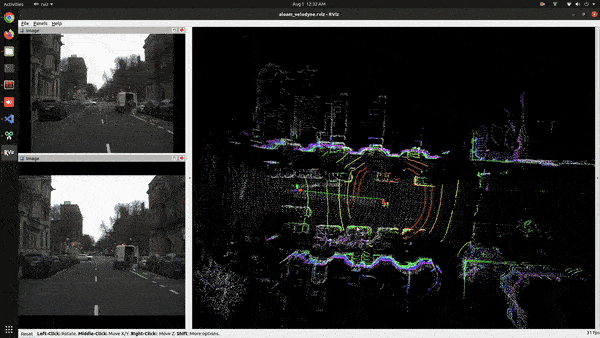
Feature Point Extraction
Feature points are defined as edge points and planar points. But, how to decide if any point is an edge or planar? For that the authors defined a term ![]() to evaluate the smoothness of the local surface,
to evaluate the smoothness of the local surface,
![]() =
= 
![]()
- Let,
 be the set of consecutive points around
be the set of consecutive points around  , captured by the laser scanner. if
, captured by the laser scanner. if  is a LiDAR point cloud data from sweep
is a LiDAR point cloud data from sweep  , and
, and  are the series of points captured by the LiDAR during scan
are the series of points captured by the LiDAR during scan  , then
, then  would be a subset of these points, including
would be a subset of these points, including  and its immediate neighbours.
and its immediate neighbours. - ∥

∥ denotes the norm of the vector  (coordinates of point
(coordinates of point  ,
,  , in
, in  ).
).  represents the sum of the differences between the point
represents the sum of the differences between the point 
and each point in 
in set  , excluding the point
, excluding the point  .
.
How does the above equation represent a surface smoothness?
- A lower value of
 indicates that the neighbouring points are close to point
indicates that the neighbouring points are close to point  , implying a smoother local planar surface. On a planar surface patch, the neighbouring points around a point
, implying a smoother local planar surface. On a planar surface patch, the neighbouring points around a point  will be closely aligned and evenly spaced.
will be closely aligned and evenly spaced. - A higher value of
 suggests greater deviation among the neighbouring points, indicating a rougher or more irregular local surface. This indicates an edge point. For a point identified as an edge, there should be a significant change in the surface’s orientation or a sharp discontinuity.
suggests greater deviation among the neighbouring points, indicating a rougher or more irregular local surface. This indicates an edge point. For a point identified as an edge, there should be a significant change in the surface’s orientation or a sharp discontinuity.
To evenly distribute the feature points within the environment, we separate a scan into four identical sub-regions. Each sub-region can provide maximally 2 edge points and 4 planar points. A point
— LOAM: Lidar Odometry and Mapping in Real-timecan be selected as an edge or a planar point only if its
value is larger or smaller than a threshold, and the number of selected points does not exceed the maximum.
By ensuring an even distribution of feature points in the four sub-regions, the overall quality, accuracy, and robustness of the scan analysis and subsequent applications (like mapping, object recognition, and navigation) are significantly improved.
How to select feature points?
Feature points are chosen based on their smoothness values: the sharpest edges (highest ![]() values) and the flattest surfaces (lowest
values) and the flattest surfaces (lowest ![]() values). When selecting these points:
values). When selecting these points:
- There’s a limit on how many can be chosen in each area.
- Points that are too close to already selected ones are skipped.
- Points on surfaces parallel to the laser beam or near edges of hidden areas are also avoided.
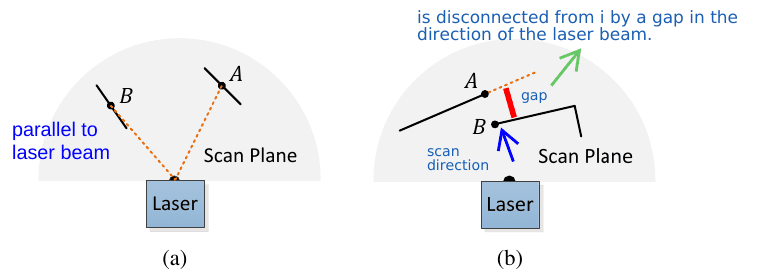
The above diagram represents the third point visually. Figure 5 (a), shows that point B is in a surface patch parallel to the laser beam, but point A’s surface has an angle with the beam, so point A is taken as a feature point.
In Figure 5 (b), point A is not taken as a feature point because even though from the current point of view, it seems occluded, but from a different perspective, it might be observable, which makes it unreliable.
Feature Correspondences

Say, ![]() is the starting time of a sweep k, the point cloud received during the sweep is
is the starting time of a sweep k, the point cloud received during the sweep is ![]() . Now the 2nd sweep
. Now the 2nd sweep ![]() happens, the starting time can be thought as
happens, the starting time can be thought as ![]() , and the points collected during the sweep is
, and the points collected during the sweep is ![]() . To have all the scanned points in the same time stamp we reproject the
. To have all the scanned points in the same time stamp we reproject the ![]() points at
points at ![]() , these re-projected points represented as
, these re-projected points represented as ![]() .
.
Now, that we have both the point clouds in the same timestamp we can find the correspondences. We take the ![]() and find a set of edge points
and find a set of edge points ![]() and planar points
and planar points ![]() from the LiDAR point cloud using the methodology discussed in the previous step. Then we find edge points from
from the LiDAR point cloud using the methodology discussed in the previous step. Then we find edge points from ![]() as the correspondences for the points in
as the correspondences for the points in ![]() , and planar patches as the correspondences for the points in
, and planar patches as the correspondences for the points in ![]() . At each iteration,
. At each iteration, ![]() and
and ![]() are reprojected to the beginning of the sweep using the currently estimated transform, say after reprojection it’s named as
are reprojected to the beginning of the sweep using the currently estimated transform, say after reprojection it’s named as ![]() and
and ![]() .
.
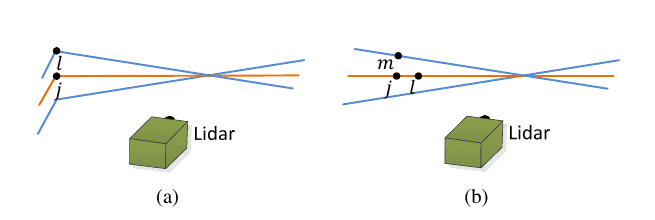
- At
 we have point cloud
we have point cloud 
- At
 , we get
, we get  and
and  and re-project
and re-project  to get
to get  . The orange line represent that scan line.
. The orange line represent that scan line. - At
 , we reproject
, we reproject  and
and  to get
to get  and
and  .
. - There are also two consecutive scans after
 , represented with two blue lines.
, represented with two blue lines.
Now the task is to find the feature correspondences, between a point from E_bar with point in those two consecutive scans and the re-projected scan. Given, ![]() , a point from
, a point from ![]() ,
, ![]() (a point found from
(a point found from ![]() ) and
) and ![]() (a point found from one of those consecutive scans) are the two points that are closest neighbour of
(a point found from one of those consecutive scans) are the two points that are closest neighbour of ![]() . Finally,
. Finally, ![]() forms the edge line correspondence of
forms the edge line correspondence of ![]() . The edge line is represented by two points.
. The edge line is represented by two points.
A planar patch is represented by three points. Say ![]() is a point where
is a point where ![]() . As a correspondence of i we need to find 3 points. Similar to the last paragraph, we find the closest neighbour of
. As a correspondence of i we need to find 3 points. Similar to the last paragraph, we find the closest neighbour of ![]() in
in ![]() , denoted as
, denoted as ![]() . Another point
. Another point ![]() found from the same scan as
found from the same scan as ![]() given its closest to
given its closest to ![]() , and another point
, and another point ![]() is found from one of the two consecutive scans. This guarantees that the three points are non-colinear.
is found from one of the two consecutive scans. This guarantees that the three points are non-colinear.
We compute the distance between the feature points to its correspondences and minimize them to compute the LiDAR motion. We compute the distance between the feature edge point and the correspondence edge line using equation ![]() , and the distance between the feature planar point to its correspondence planar patch using equation
, and the distance between the feature planar point to its correspondence planar patch using equation ![]() .
.
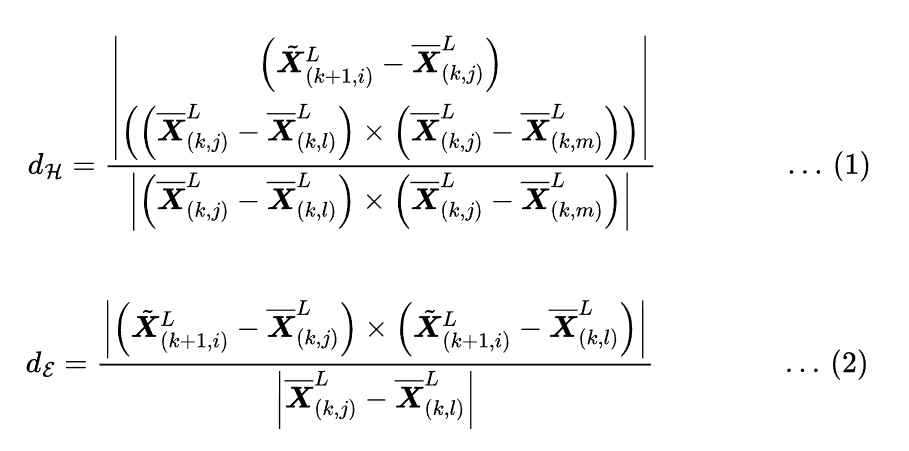
Where, ![]() ,
, ![]() , and
, and ![]() are the coordinates of points
are the coordinates of points ![]() ,
, ![]() , and
, and ![]() in
in ![]() (
(![]() means LiDAR frame of reference), respectively and
means LiDAR frame of reference), respectively and ![]() is the coordinates of point
is the coordinates of point ![]() in
in ![]() .
.
Estimate the LiDAR Motion
Now that we have calculated correspondences we can use that to calculate the LiDAR ego-motion. LiDAR motion has 6-DoF. We can linearly interpolate the pose transform within a sweep for the points that are received at different times.
Let ![]() be the current timestamp, and recall that
be the current timestamp, and recall that ![]() is the starting time of sweep
is the starting time of sweep ![]() . From time
. From time ![]() to
to ![]() the lidar motion can be defined as
the lidar motion can be defined as ![]() . Say, at time
. Say, at time ![]() we get some point. So the transform,
we get some point. So the transform, ![]() (represented as (
(represented as (![]() )) from time
)) from time ![]() to
to ![]() , can be calculated using,
, can be calculated using,

Apart from reducing the distance between the feature point and correspondences, we also need to establish a geometric relationship between ![]() and
and ![]() or
or ![]() and
and ![]() . Below equation represents that,
. Below equation represents that,

Here,
 : The coordinates of a point
: The coordinates of a point  in
in  (set of edge points) or
(set of edge points) or  (set of planar points).
(set of planar points). : The corresponding reprojected point in
: The corresponding reprojected point in  (reprojected edge points) or
(reprojected edge points) or  (reprojected planar points).
(reprojected planar points). : The a-th to b-th entries of the LiDAR pose
: The a-th to b-th entries of the LiDAR pose  , representing translation or displacement.
, representing translation or displacement. : A rotation matrix defined by the Rodrigues formula.
: A rotation matrix defined by the Rodrigues formula.
Observed correctly, you can understand that it’s the 1st equation of the Epipolar Geometry section from the monocular slam blog post, explaining the 3D to 3D transformation from ![]() to
to ![]() .
.
Rodrigues Formula
The Rodrigues formula is a mathematical expression used to convert a rotation vector (axis-angle representation) into a rotation matrix.
Given a rotation vector ![]() , the magnitude
, the magnitude ![]() represents the angle of rotation, and the unit vector
represents the angle of rotation, and the unit vector ![]() represents the axis of rotation. The rotation matrix
represents the axis of rotation. The rotation matrix ![]() can be computed using the Rodrigues formula:
can be computed using the Rodrigues formula:

![]() is calculated as,
is calculated as,

and ![]() is calculated as,
is calculated as,

![]() is the skew symmetric matrix of
is the skew symmetric matrix of ![]() .
.
LiDAR Transformation Calculation
Now that we have the distance equations ![]() and the projection point relation
and the projection point relation ![]() , using those authors came up with more simpler version of distance equations, where we can minimize the distance to recover the transformation
, using those authors came up with more simpler version of distance equations, where we can minimize the distance to recover the transformation ![]() (LiDAR motion from time
(LiDAR motion from time ![]() till
till ![]() ). The geometric relationship between an edge point in
). The geometric relationship between an edge point in ![]() and the corresponding edge line (found from feature correspondences) and points in
and the corresponding edge line (found from feature correspondences) and points in ![]() and corresponding planar patches (found from feature correspondences) is derived as,
and corresponding planar patches (found from feature correspondences) is derived as,

Authors combine these two equations to obtain a nonlinear function,

This nonlinear function is solved by minimizing ![]() towards zero. To do that first this nonlinear function can be linearized and represented as a least squares problem. This involves minimizing the sum of squared residuals:
towards zero. To do that first this nonlinear function can be linearized and represented as a least squares problem. This involves minimizing the sum of squared residuals:
The residual function ![]() can be approximated linearly around the current estimate
can be approximated linearly around the current estimate ![]()

Here,
 represents a small change in the parameters.
represents a small change in the parameters. is the Jacobian matrix of
is the Jacobian matrix of  with respect to
with respect to  .
.  is the current estimate of the transformation.
is the current estimate of the transformation.
In a least squares problem, we aim to minimize the sum of squared residuals:

Using the linear approximation, this can be written as:

Expanding this, we get:

Simplifying, this becomes:

To minimize this quadratic form, we take the derivative with respect to ![]() and set it to zero:
and set it to zero:

The derivative is:

Rearranging, we get the normal equation:
To solve for ![]() :
:
From the Levenberg-Marquardt algorithm, a damping factor ![]() is introduced to combine the gradient descent and Gauss-Newton methods, improving the convergence properties. The update equation becomes:
is introduced to combine the gradient descent and Gauss-Newton methods, improving the convergence properties. The update equation becomes:
![]()
Finally, the parameters are updated using the computed ![]() :
:
LiDAR Odometry Pseudo Code
Now that we have derived the motion estimation equation, it would be very easy to iterate through the LiDAR Odometry Algorithm. If you were not able to follow in the previous steps, its your time to catch up. We will be referencing the line numbers mentioned in the below image to explain each step.
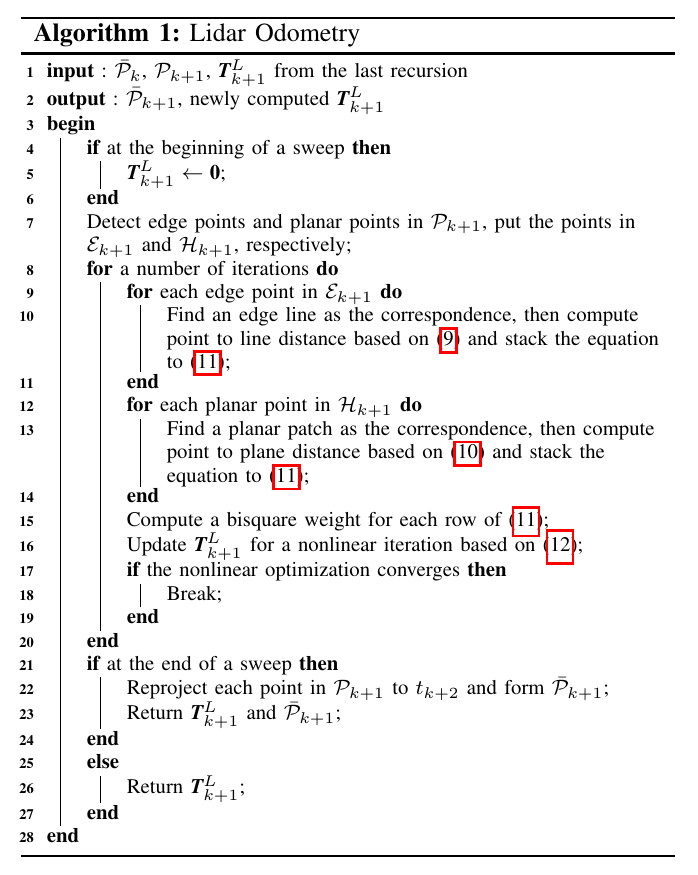
Inputs are,
 = Reprojected pointcloud captured in the k-th sweep
= Reprojected pointcloud captured in the k-th sweep = The point cloud from k+1-th sweep
= The point cloud from k+1-th sweep = lidar pose transform between time
= lidar pose transform between time ![[t_{k+1}, t]](data:image/gif;base64,R0lGODlhAQABAAAAACH5BAEKAAEALAAAAAABAAEAAAICTAEAOw==)
Outputs are,
 = Reprojected
= Reprojected  to
to  and form
and form 
 = updated
= updated 
Say, there is a car with LiDAR attached to it. to get the LiDAR odometry we follow the above algorithm,
at ![]() (LiDAR starts capturing scans), we get a
(LiDAR starts capturing scans), we get a ![]() .
.
at ![]() we get
we get ![]() .
.
Say the transformation from ![]() to
to ![]() is
is ![]() . At the beginning
. At the beginning ![]() set to 0 (line 4-5), because we consider the starting point as the coordinate center.
set to 0 (line 4-5), because we consider the starting point as the coordinate center.
In line 7, feature points from ![]() and
and ![]() are captured and stored based on the
are captured and stored based on the ![]() values. For a
values. For a ![]() number of iteration we, find the edge line correspondences, and compute the edge feature point to edge line distance using the equation
number of iteration we, find the edge line correspondences, and compute the edge feature point to edge line distance using the equation ![]() and the resulting equation is stacked in the form of equation
and the resulting equation is stacked in the form of equation ![]() (line 9-11). Again for the planar feature points we do the same as above (line 12-14).
(line 9-11). Again for the planar feature points we do the same as above (line 12-14).
Compute the bisquare weights for each row of the finally formed ![]() equation. Here, bisquare weight is a weight assigned to each data point based on its residual (d), reducing the influence of points with large residuals (outliers) [Line 15].
equation. Here, bisquare weight is a weight assigned to each data point based on its residual (d), reducing the influence of points with large residuals (outliers) [Line 15].
In line 16 we update the ![]() based on the equation
based on the equation ![]() . If the distance comes to a minimum (optimization converges), we break the loop.
. If the distance comes to a minimum (optimization converges), we break the loop.
At the end of the ![]() sweep,
sweep, ![]() is reprojected to
is reprojected to ![]() to form
to form ![]() and we return, estimated
and we return, estimated ![]() and
and ![]() . This
. This ![]() ,
, ![]() and the scan at
and the scan at ![]() will be used as an input in the next iteration. Else, we directly return the updated
will be used as an input in the next iteration. Else, we directly return the updated ![]() [Line 21-27].
[Line 21-27].
LiDAR Mapping
Mapping part is the easiest part of LOAM. As we are considering the vehicle starting position as the world coordinate center, the LiDAR pose transform, w.r.t LiDAR and World is same ![]() .
.
The output of LiDAR Odometry is ![]() and the undistorted point cloud in LiDAR coordinate.
and the undistorted point cloud in LiDAR coordinate.
The problem is, to bring the point cloud in the world coordinate and add the transform of LiDAR pose to stitch the scans. Here the 3D to 3D transformation equation will come to play,
![]()
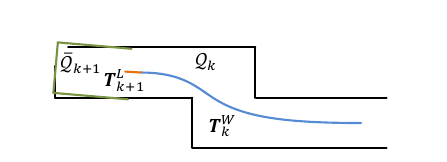
The above image explains the process in detail,
- The blue curve represents the LiDAR pose on the map
 generated by the mapping algorithm at sweep
generated by the mapping algorithm at sweep  .
. - The orange curve shows the LiDAR motion during sweep
 ,
,  computed by the odometry algorithm.
computed by the odometry algorithm. - Using
 and
and  , the odometry algorithm projects the undistorted point cloud onto the map as
, the odometry algorithm projects the undistorted point cloud onto the map as  (green line segments), matching it with the existing map cloud
(green line segments), matching it with the existing map cloud  (black line segments).
(black line segments). - Based on this
 and
and  matching, lidar pose
matching, lidar pose  is being optimized.
is being optimized.
LeGO-LOAM Paper Summary
LeGO LOAM paper is an extraction of the LOAM paper. The novelty of this LiDAR SLAM method lies in incorporating ground segmentation to enhance feature extraction and two step pose optimization. The overall system is divided into five modules,
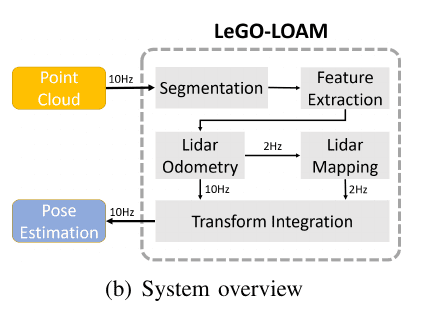
Ground Segmentation
Ground segmentation is done by projecting the 3D points in a 2D plane. This projection creates a range image also known as a depth map. The range value ![]() that is associated with
that is associated with ![]() represents the Euclidean distance from the corresponding point
represents the Euclidean distance from the corresponding point ![]() to the sensor.
to the sensor.
// imageProjection.cpp from line 196
// define range image
Eigen::MatrixXf _range_mat;
// calculate eucladian distance
float range = sqrt(thisPoint.x * thisPoint.x +
thisPoint.y * thisPoint.y +
thisPoint.z * thisPoint.z);
// find the row and column index in the image for this point
float verticalAngle = std::asin(thisPoint.z / range);
int rowIdn = (verticalAngle + _ang_bottom) / _ang_resolution_Y;
float horizonAngle = std::atan2(thisPoint.x, thisPoint.y);
int columnIdn = -round((horizonAngle - M_PI_2) / _ang_resolution_X) + _horizontal_scans * 0.5;
// assign the range value to the range image
_range_mat(rowIdn, columnIdn) = range;
The resolution of the range image for the VLP-16 is 800 by 16 pixels. This means:
- 1800 pixels in x axis, which spans 360 degrees with a resolution of 0.2 degrees per pixel.
// imageProjection.cpp from line 101
_ang_resolution_X = (M_PI*2) / (_horizontal_scans);
- 16 pixels correspond to the vertical field of view, which spans approximately 30 degrees with a resolution of 2 degrees per pixel.
// imageProjection.cpp from line 107
_ang_resolution_Y = DEG_TO_RAD*(vertical_angle_top - _ang_bottom) / float(_vertical_scans-1);
A column-wise evaluation of the range image, which can be viewed as ground plane estimation, is conducted for ground point extraction before segmentation.
Each column in the range image corresponds to a set of LiDAR points that were captured along the same azimuth angle but at different elevations. In other words, a column represents a vertical profile of the scene. In ground segmentation -1 as label is taken as an invalid point, 0 is the initial value and 1 is ground point.
// imageProjection.cpp from line 283
// vertical angle, adjusted by the sensor mount angle, is less than or equal
// to 10 degrees (converted to radians), the points are marked as ground
if ( (vertical_angle - _sensor_mount_angle) <= 10 * DEG_TO_RAD) {
_ground_mat(i, j) = 1;
_ground_mat(i + 1, j) = 1;
}
Ground plane generally exhibits certain characteristics,
- It is usually the lowest set of points in the vertical profile.
- It tends to be relatively flat or smoothly varying compared to other objects in the scene
- Check the slopes between adjacent points in the column. Ground points usually form a continuous surface with small slopes.
Algorithm Implementation:
- For each column in the range image, start from the bottom and move upwards.
- Identify the first few points that meet the criteria for ground points (e.g., height threshold, slope threshold).
- Mark these points as belonging to the ground plane.
- Continue to the next column and repeat the process.
Authors used flood-fill algorithm for the segmentation of the range image.
- Initially, a point
 from the range image is taken and assigned a label.
from the range image is taken and assigned a label. - For each point
 , we look for its immediate neighbours pixels.
, we look for its immediate neighbours pixels. - If the neighbouring point is already labeled, it is skipped.
- Next maximum and minimum ranges calculated between the current point and the neighbour.
- Then tangent value is calculated from angular resolution. tangent value used to check if the angle difference between the points exceeds the threshold.
- If tangent value meets the threshold, the neighbouring point is labeled.
- This goes on until all points in the queue are traversed.
// imageProjection.cpp from line 388
const Coord2D neighborIterator[4] = {
{0, -1}, {-1, 0}, {1, 0}, {0, 1}};
// The algorithm runs a loop as long as there are points in the queue.
while (queue.size() > 0) {
// Pop point
Coord2D fromInd = queue.front();
queue.pop_front();
// Mark popped point
_label_mat(fromInd.x(), fromInd.y()) = _label_count;
// Loop through all the neighboring grids of popped grid
for (const auto& iter : neighborIterator) {
// new index
int thisIndX = fromInd.x() + iter.x();
int thisIndY = fromInd.y() + iter.y();
// index should be within the boundary
if (thisIndX < 0 || thisIndX >= _vertical_scans){
continue;
}
// at range image margin (left or right side)
if (thisIndY < 0){
thisIndY = _horizontal_scans - 1;
}
if (thisIndY >= _horizontal_scans){
thisIndY = 0;
}
// prevent infinite loop (caused by put already examined point back)
if (_label_mat(thisIndX, thisIndY) != 0){
continue;
}
float d1 = std::max(_range_mat(fromInd.x(), fromInd.y()),
_range_mat(thisIndX, thisIndY));
float d2 = std::min(_range_mat(fromInd.x(), fromInd.y()),
_range_mat(thisIndX, thisIndY));
// alpha is the angular resolution based on whether the neighbor is vertical or horizontal.
float alpha = (iter.x() == 0) ? _ang_resolution_X : _ang_resolution_Y;
// tang is the tangent value used to check if the angle difference between the points exceeds
// the threshold (segmentThetaThreshold).
float tang = (d2 * sin(alpha) / (d1 - d2 * cos(alpha)));
// the neighboring point is pushed into the queue and all_pushed, and it is labeled with _label_count.
if (tang > segmentThetaThreshold) {
queue.push_back( {thisIndX, thisIndY } );
_label_mat(thisIndX, thisIndY) = _label_count;
lineCountFlag[thisIndX] = true;
all_pushed.push_back( {thisIndX, thisIndY } );
}
}
}
A clustering algorithm is applied to the range image to group points into clusters. Each cluster is assigned a unique number. The ground points are considered a unique type of cluster with a specific label. Then omit the cluster that has less than 30 points.
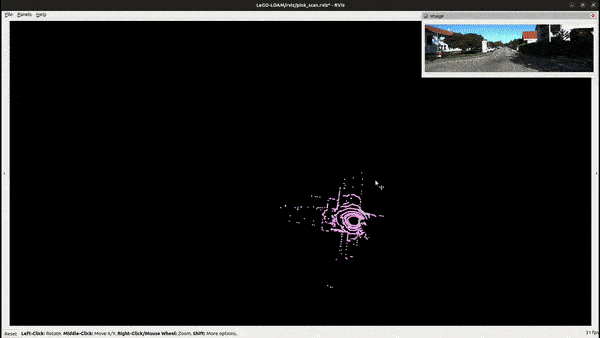
Feature Extraction
For feature extraction a set of continuous points of ![]() from the same row of the range image is taken, let’s call it
from the same row of the range image is taken, let’s call it ![]() , and the size of
, and the size of ![]() is 10. For a point
is 10. For a point ![]() , the set
, the set ![]() takes 5 points before
takes 5 points before ![]() and 4 points after
and 4 points after ![]()
For the above formula, code implementation is shown below. Within the loop -segInfo.segmented_cloud_range[i] * 10 is similar to ![]() and the modulus is done here,
and the modulus is done here, cloudCurvature[i] = diffRange * diffRange. Although its shown in the equation that the summation is normalized by the product of the number of points ![]() and the magnitude
and the magnitude ![]() , but it is not shown in the code.
, but it is not shown in the code.
void FeatureAssociation::calculateSmoothness() {
int cloudSize = segmentedCloud->points.size();
for (int i = 5; i < cloudSize - 5; i++) {
float diffRange = segInfo.segmented_cloud_range[i - 5] +
segInfo.segmented_cloud_range[i - 4] +
segInfo.segmented_cloud_range[i - 3] +
segInfo.segmented_cloud_range[i - 2] +
segInfo.segmented_cloud_range[i - 1] -
segInfo.segmented_cloud_range[i] * 10 +
segInfo.segmented_cloud_range[i + 1] +
segInfo.segmented_cloud_range[i + 2] +
segInfo.segmented_cloud_range[i + 3] +
segInfo.segmented_cloud_range[i + 4] +
segInfo.segmented_cloud_range[i + 5];
cloudCurvature[i] = diffRange * diffRange;
cloudNeighborPicked[i] = 0;
cloudLabel[i] = 0;
cloudSmoothness[i].value = cloudCurvature[i];
cloudSmoothness[i].ind = i;
}
}
To evenly extract features from all directions, the range image is divided horizontally into 6 sub-images. Then the roughness values ![]() for each point
for each point ![]() in a row are sorted. Then similar to LOAM, thresholding is applied on c to extract the edge and planar feature points.
in a row are sorted. Then similar to LOAM, thresholding is applied on c to extract the edge and planar feature points.
std::sort(cloudSmoothness.begin() + sp, cloudSmoothness.begin() + ep, by_value());
There are ![]() and
and ![]() which is the global edge and planar from all the sub-images. In
which is the global edge and planar from all the sub-images. In ![]() edge feature points do not belong to the ground,
edge feature points do not belong to the ground, ![]() are the planar points that belong to the ground or any other segmented section.
are the planar points that belong to the ground or any other segmented section.
![]() and
and ![]() are the subset of
are the subset of ![]() and
and ![]() edge and planar features, where
edge and planar features, where ![]() only belongs to non-ground sections and
only belongs to non-ground sections and ![]() is from only ground segments.
is from only ground segments. ![]() ,
,![]() and
and ![]() ,
,![]() are visualized below,
are visualized below,
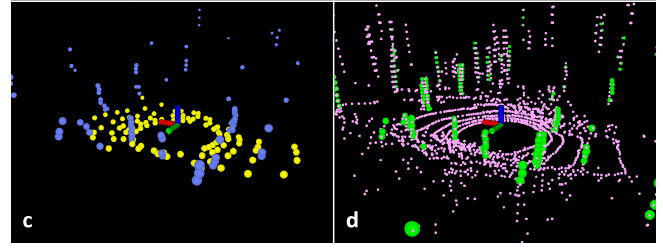
The code of the feature extraction is provided in the extractFeatures function of featureAssociation.cpp. Odometry calculation is done in the same file as well.
Lidar Odometry
The transformation between two scans is found by performing point-to-edge and point-to-plane scan-matching. This matching is done between the features ![]() in current scan and the previous scans
in current scan and the previous scans ![]() and
and ![]() . Matching is done using the method mentioned in LOAM. The two important changes that made the feature matching more efficient are,
. Matching is done using the method mentioned in LOAM. The two important changes that made the feature matching more efficient are,
- Label matching: The matching is done between the current and previous scan that has the same labels.
- Two-step L-M Optimization: Authors used the Levenberg-Marquardt (L-M) method to minimize the distance between corresponding feature points to estimate the transformation. But, there is a catch, L-M optimization done in two steps, 3 out of 6 motion parameters
 are estimated using the planar features of current and previous scan and remaining
are estimated using the planar features of current and previous scan and remaining  is estimated using the edge feature points of current and previous scan taking
is estimated using the edge feature points of current and previous scan taking  as constraints. They have observed a computation reduction of 35% using the 2 step optimization method.
as constraints. They have observed a computation reduction of 35% using the 2 step optimization method.
In the featureAssociation.cpp file you will find the edge and planar feature correspondence code in the findCorrespondingCornerFeatures and findCorrespondingSurfFeatures functions. The transformation between edge and planar patches are done in the calculateTransformationCorner and calculateTransformationSurf respectively. As you can see, the transformation calculations of the 6 motion parameters are split between these two functions.
Lidar Mapping
Mapping is the registration of the current scan to the global point cloud map. The global code is represented as ![]() . The L-M method is used here to refine the pose estimation, and the final transformation is obtained from here. Drift estimation is done for this module by performing loop closure detection. In this case, new constraints are added if a match is found between the current feature set and a previous feature set using ICP. The estimated pose of the sensor is then updated by sending the pose graph to an optimization system.
. The L-M method is used here to refine the pose estimation, and the final transformation is obtained from here. Drift estimation is done for this module by performing loop closure detection. In this case, new constraints are added if a match is found between the current feature set and a previous feature set using ICP. The estimated pose of the sensor is then updated by sending the pose graph to an optimization system.
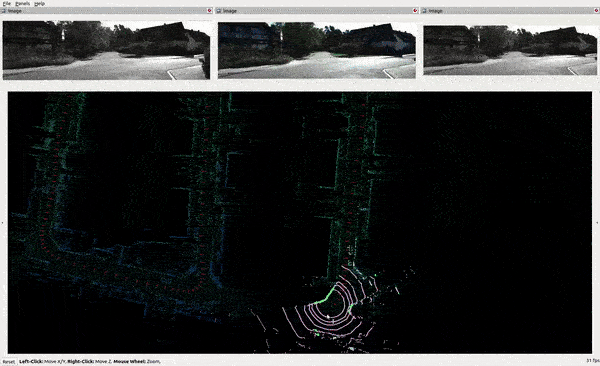
The scan2MapOptimization method in the MapOptimization class performs an iterative optimization process to align the current LiDAR scan with the existing map. It first checks if there are sufficient corner and surface points. It then sets up KD-trees for fast nearest-neighbor searches. The method runs up to 10 iterations where it clears previous optimization data, performs corner and surface optimizations to compute residuals and coefficients, and applies the Levenberg-Marquardt algorithm (LMOptimization) to update the transformation parameters. If the optimization converges within these iterations, the loop breaks early. Finally, it updates the transformation parameters based on the optimized values.
void MapOptimization::scan2MapOptimization() {
if (laserCloudCornerFromMapDSNum > 10 && laserCloudSurfFromMapDSNum > 100) {
kdtreeCornerFromMap.setInputCloud(laserCloudCornerFromMapDS);
kdtreeSurfFromMap.setInputCloud(laserCloudSurfFromMapDS);
for (int iterCount = 0; iterCount < 10; iterCount++) {
laserCloudOri->clear();
coeffSel->clear();
cornerOptimization();
surfOptimization();
if (LMOptimization(iterCount) == true) break;
}
transformUpdate();
}
}
Explanation of main.cpp :
This code snippet creates and runs a multi-threaded ROS 2 (Robot Operating System 2) executor with four nodes and four threads. The nodes include:
- ImageProjection (
IP): Projects LiDAR points onto an image plane. - FeatureAssociation (
FA): Associates features from the projected image with the current scan and previous scans. - MapOptimization (
MO): Optimizes the map using the associated features. - TransformFusion (
TF): Fuses transformations from different sources.
The MultiThreadedExecutor allows these nodes to run concurrently on four threads, improving performance by parallelizing their execution. The executor.spin() function keeps the executor running, processing callbacks from the nodes.
The channel.h file defines a template class named Channel that provides a simplistic mechanism for moving information between two threads in a thread-safe manner. This implementation is designed to work with only one writer and one reader, and it is not buffered. The class uses a combination of a mutex (std::mutex), a condition variable (std::condition_variable), and a boolean flag to manage access to the shared resource (_item) between the threads.
ProjectionOut is a structure consisting of two pcl point cloud data and point cloud info message type.
Setup and Run LeGO-LOAM with ROS 2
Below are the steps to run the LeGO-LOAM.
Dependency Management:
To install ROS 2 follow the guide from the article, “setup guide ros2 carla”. Install eigen, boost and gtsam.
Install boost:
# install boost
$ sudo apt install libboost-all-dev # experimented with version 1.74.0
Install Eigen:
# remove eigen if you already have, sudo apt-get remove libeigen3-dev
$ wget https://gitlab.com/libeigen/eigen/-/archive/3.3.7/eigen-3.3.7.zip
$ unzip eigen-3.3.7.zip
$ cd eigen-3.3.7
$ mkdir build && cd build
$ cmake ..
$ sudo make install
Install GTSAM:
$ wget https://github.com/borglab/gtsam/archive/refs/tags/4.2.zip
$ unzip gtsam-4.2.zip
$ cd gtsam-4.2
$ mkdir build && cd build
$ cmake ..
$ sudo make install
Install ROS 2 Dependencies:
$ sudo apt-get install ros-humble-tf2-geometry-msgs ros-humble-tf2-eigen ros-humble-pcl-conversions ros-humble-pcl-ros ros-humble-velodyne ros-humble-velodyne-pointcloud ros-humble-tf2-kdl ros-humble-geometry2 ros-humble-tf2-sensor-msgs ros-humble-tf2-eigen-kdl ros-humble-dummy-robot-bringup ros-humble-rviz2 ros-humble-rviz-default-plugins ros-humble-interactive-markers ros-humble-rviz-common ros-humble-rviz-rendering ros-humble-orocos-kdl-vendor
$ pip3 install rosbags>=0.9.11
Clone LeGO-LOAM:
$ git clone https://github.com/fishros/LeGO-LOAM-ROS2.git
Modify the CMakeLists.txt and LiDAR Topic Name:
This file needs to be modified for easy compilation of the LeGO-LOAM repository. This file can be found at LeGO-LOAM-ROS2/LeGO-LOAM/CMakeLists.txt. there are two modifications,
find_package(Eigen3 REQUIRED)should be changed tofind_package(Eigen3 3.3.7 REQUIRED)- Add
include_directories(${EIGEN3_INCLUDE_DIR})afterinclude_directories(include).
To modify the topic name find the file imageProjection.cpp and in the 46th line change /rslidar_points to /velodyne_points.
Either do all the above or download the code from below which is the entire learnopencv code repository. Clone the repository, find this article code folder and just run below commands, given the dependencies are met.
$ cd LeGO-LOAM-ROS2
$ colcon build
$ source install/setup.bash
Download the bag file from this link, and this link has the lidar scans that we want to use to perform the LiDAR SLAM using the LeGO-LOAM system. But, right now it’s a ROS 1 bag file, we need to convert it to ROS 2 bag file. to do so run the below command,
$ rosbags-convert nsh_indoor_outdoor.bag
Run the LeGO-LOAM:
# in a seperate terminal
$ ros2 launch lego_loam_sr run.launch.py
# in a seperate terminal
$ ros2 bag play nsh_indoor_outdoor
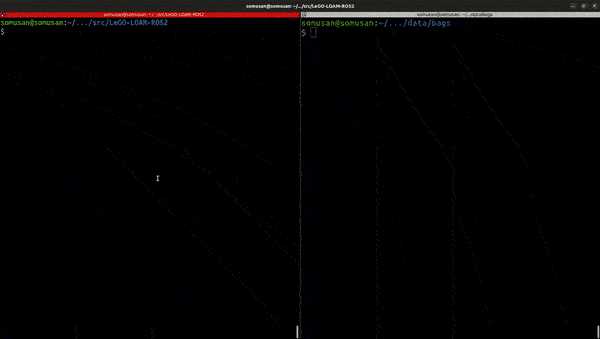
Key Takeaways
Important take away from this article are,
- Detail understand of the LOAM paper, and how the LiDAR pose is calculated with the detail derivation.
- Following up with the LeGO-LOAM paper, which is much advance than LOAM. We went though the the algorithm and how Odometry and Mapping is achieved.
- We also covered the code explanation of few parts of LeGO-LOAM.
- We finally showed how to run LeGO-LOAM on ROS 2.
Conclusion
The journey from understanding the basic problem of LiDAR SLAM to implementing it in a real-world scenario highlights the complexity and elegance of this field. Whether it’s the meticulous extraction of feature points, the innovative use of ground segmentation in LeGO-LOAM, or the optimization techniques that refine the LiDAR’s pose, each step contributes to creating a precise and reliable map of the environment.
To continue your journey in robotics perception, make sure to check out our other articles in this series, where we cover everything from Monocular SLAM to setting up ROS 2 with Carla. With each post, you’ll build a solid foundation in the key technologies shaping the future of autonomous systems.
References
[ 1 ] LOAM: Lidar Odometry and Mapping in Real-time
[ 2 ] LeGO-LOAM: Lightweight and Ground-Optimized Lidar Odometry and Mapping on Variable Terrain





